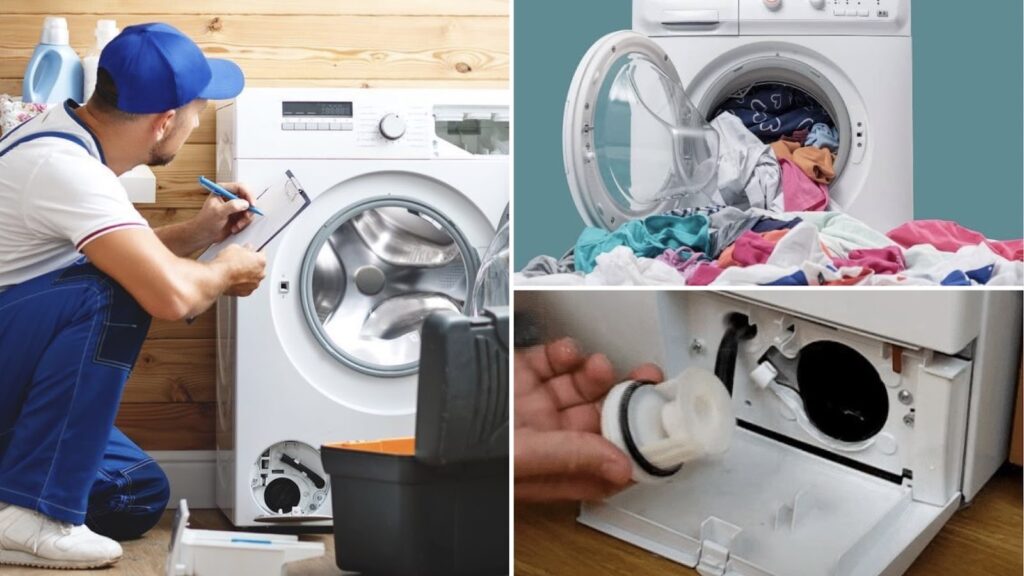A washing machine not draining properly can turn your laundry day into a major headache. Instead of feeling frustrated, read this blog post till the end.
Source: Pinterest
We’ll enlighten you with the common reasons why your washing machine might be giving you trouble and how you can fix it yourself. Are you ready? Let’s get to it.
Check the Drain Hose
One of the most common reasons for a washing machine not draining is a clogged or kinked drain hose. The hose is responsible for carrying water out of the machine. As a result, any blockage in it can prevent the water from exiting as it should.
Source: Pinterest
Make sure to carefully inspect the hose for bends or obstructions. If you find any, straighten them out or remove debris.
Inspect the Washing Machine’s Pump Filter
If your washing machine is still not draining, the next thing to check is the pump filter. Over time, small items like lint, coins, or buttons can get stuck in the filter. This usually results in the water flow to slow or stop completely.
Source: Pinterest
To fix this, turn off your machine and locate the filter (usually found at the front bottom of the washer). Next, remove any buildup or debris. Regular cleaning of this filter is one of the easiest ways to avoid future issues.
Check for Blockages in the Drain Pump
Another reason why a washing machine might not drain properly is a blockage in the drain pump itself. This can happen if something has been sucked into the pump, preventing it from pushing water out.
Source: Pinterest
You may need to remove the pump and check for any debris caught inside. Unsure how to do this? Your washing machine’s manual will have specific instructions on how to access and clean the pump.
Is the Lid Switch Malfunctioning?
For top-loading washing machines, a malfunctioning lid switch could be another reason your washing machine isn’t draining. The lid switch ensures that the washing machine only operates when the lid is securely closed.
Source: Pinterest
If this switch is faulty, the machine may stop draining as a safety precaution. You can test the lid switch by pressing it manually. If you suspect it’s broken, it might be time for a replacement.
Inspect the Water Pump Belt
In some washing machines, a water pump belt helps the pump move water out. Over time, this belt can wear out or break, causing the washing machine not to drain properly.
Source: Pinterest
If your machine has a belt-driven pump, check the belt for signs of damage or wear. Replacing a worn-out belt is a relatively straightforward fix that can solve your draining problem.
Is There a Problem with the Control Board?
In modern washing machines, the control board regulates the machine’s functions, including draining. A malfunction in the control board could stop your machine from draining properly.
Source: Pinterest
If all other parts seem to be in good condition and your washing machine still isn’t draining, it could be worth looking into the control board. This fix may require professional assistance if you’re not familiar with electronics.
Make Sure You’re Not Overloading Your Washing Machine
Sometimes, the issue is as simple as overloading the washing machine during laundry. A washing machine not draining could be due to too much laundry packed into the drum.
Source: Pinterest
When overloaded, the machine might not be able to spin properly, which can prevent the water from draining. Always check your washer’s load limits and avoid overfilling it.
Faulty Drain Pump: When It’s Time to Call a Pro
If you’ve checked everything and your washing machine still isn’t draining, the drain pump itself could be faulty. Over time, the motor inside the pump can burn out or break.
Source: Pinterest
Replacing a drain pump can be tricky. So, if you suspect that this is the issue, it might be time to call in a professional for help.
Power Supply and Electrical Issues
Sometimes, a washing machine not draining can stem from something as basic as an electrical issue. Make sure the washing machine is properly plugged in and that there’s no problem with the outlet.
Source: Pinterest
Additionally, check the machine’s circuit breaker to ensure it hasn’t tripped. This could prevent the machine from operating.
Prevention Tips to Keep Your Washing Machine Draining Smoothly
To avoid future issues with your washing machine not draining properly, it’s essential to perform regular maintenance. Clean out the pump filter regularly.
Source: Pinterest
In addition, inspect the hoses for clogs and avoid overloading your washer. Simple preventative steps like these can keep your machine running smoothly for years to come.
Final Note for DIY Fixes and When to Call a Professional
If your washing machine is not draining, these DIY fixes should help you get to the root of the problem. But if none of these solutions work, don’t hesitate to call a professional technician to diagnose and repair the issue.
Source: Pinterest
Regular maintenance and timely fixes will keep your machine working efficiently. In turn, you can be sure that your laundry day will always be hassle-free and your clothes smelling fresh.
